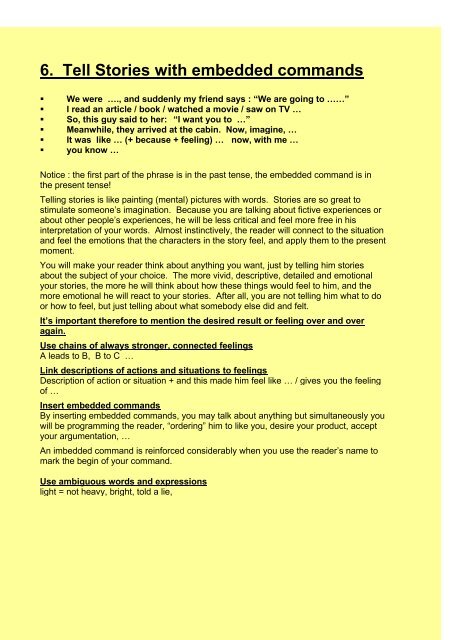HOW TO WRITE BETTER FAIRY TALES - DEAN AMORY
Complete course on writing Fairy Tales (aka Wonder Tales)
Complete course on writing Fairy Tales (aka Wonder Tales)
You also want an ePaper? Increase the reach of your titles
YUMPU automatically turns print PDFs into web optimized ePapers that Google loves.
6. Tell Stories with embedded commands<br />
We were …., and suddenly my friend says : “We are going to ……”<br />
I read an article / book / watched a movie / saw on TV …<br />
So, this guy said to her: “I want you to …”<br />
Meanwhile, they arrived at the cabin. Now, imagine, …<br />
It was like … (+ because + feeling) … now, with me …<br />
you know …<br />
Notice : the first part of the phrase is in the past tense, the embedded command is in<br />
the present tense!<br />
Telling stories is like painting (mental) pictures with words. Stories are so great to<br />
stimulate someone’s imagination. Because you are talking about fictive experiences or<br />
about other people’s experiences, he will be less critical and feel more free in his<br />
interpretation of your words. Almost instinctively, the reader will connect to the situation<br />
and feel the emotions that the characters in the story feel, and apply them to the present<br />
moment.<br />
You will make your reader think about anything you want, just by telling him stories<br />
about the subject of your choice. The more vivid, descriptive, detailed and emotional<br />
your stories, the more he will think about how these things would feel to him, and the<br />
more emotional he will react to your stories. After all, you are not telling him what to do<br />
or how to feel, but just telling about what somebody else did and felt.<br />
It’s important therefore to mention the desired result or feeling over and over<br />
again.<br />
Use chains of always stronger, connected feelings<br />
A leads to B, B to C …<br />
Link descriptions of actions and situations to feelings<br />
Description of action or situation + and this made him feel like … / gives you the feeling<br />
of …<br />
Insert embedded commands<br />
By inserting embedded commands, you may talk about anything but simultaneously you<br />
will be programming the reader, “ordering” him to like you, desire your product, accept<br />
your argumentation, …<br />
An imbedded command is reinforced considerably when you use the reader’s name to<br />
mark the begin of your command.<br />
Use ambiguous words and expressions<br />
light = not heavy, bright, told a lie,


















